Present and future perspectives for high energy density physics with intense heavy ion and laser beams
Published online by Cambridge University Press: 02 June 2005
Abstract
Intense heavy ion beams from the Gesellschaft für Schwerionenforschung (GSI, Darmstadt, Germany) accelerator facilities, together with two high energy laser systems: petawatt high energy laser for ion experiments (PHELIX) and nanosecond high energy laser for ion experiments (NHELIX) are a unique combination to facilitate pioneering beam-plasma interaction experiments, to generate and probe high-energy-density (HED) matter and to address basic physics issues associated with heavy ion driven inertial confinement fusion. In one class of experiments, the laser will be used to generate plasma and the ion beam will be used to study the energy loss of energetic ions in ionized matter, and to probe the physical state of the laser-generated plasma. In another class of experiments, the intense heavy ion beam will be employed to create a sample of HED matter and the laser beam, together with other diagnostic tools, will be used to explore the properties of these exotic states of matter. The existing heavy ion synchrotron facility, SIS18, deliver an intense uranium beam that deposit about 1 kJ/g specific energy in solid matter. Using this beam, experiments have recently been performed where solid lead foils had been heated and a brightness temperature on the order of 5000 K was measured, using a fast multi-channel pyrometer that has been developed jointly by GSI and IPCP Chernogolovka. It is expected that the future heavy ion facility, facility for antiprotons and ion research (FAIR) will provide compressed beam pulses with an intensity that exceeds the current beam intensities by three orders of magnitude. This will open up the possibility to explore the thermophysical and transport properties of HED matter in a regime that is very difficult to access using the traditional methods of shock compression. Beam plasma interaction experiments using dense plasmas with a Γ-parameter between 0.5 and 1.5 have also been carried out. This dense Ar-plasma was generated by explosively driven shockwaves and showed enhanced energy loss for Xe and Ar ions in the energy range between 5.9 to 11.4 MeV.
- Type
- Research Article
- Information
- Copyright
- 2005 Cambridge University Press
1. INTRODUCTION
Ion and laser beams offer the opportunity to concentrate energy in space and time in such a way that matter can be transformed into plasma. The system, then generally consists of a mixture of electrically charged ions, electrons, and neutral particles. In this situation collective effects, dominate the statistical properties of the sample. Atoms and ions immersed in plasma environment experience perturbations from the plasma through collisions and Coulomb interaction processes mainly. As a result the atomic and ionic states turn out to be mixed, and become strongly different from the originally pure, unperturbed atomic states, and they are different as well from the situation of a cold matter environment. Consequently not only the spectral characteristics of radiation emission and absorption by atoms and ions in plasma are substantially different from spectra of the unperturbed species, but also bulk matter properties (Rosmej et al., 2005). These can be expressed in terms of an equation-of-state, relating pressure and temperature to the matter density of the sample, by the electrical, thermal conductivity, and radiation transport properties. In general these properties turn out to be vastly different from those of matter under ordinary conditions. Interaction processes of heavy ions with plasma, like energy deposition and charge changing cross sections are known to be affected (Hoffmann et al., 1990; Dietrich et al., 1992), and change by more than one order of magnitude (Jacoby et al., 1995). Only for a few cases, where the plasma is ideal, and fully ionized, experimental data exist and can be explained within the framework of a modified Bethe-Bohr-Bloch stopping theory. For dense, non-ideal, and partially ionized plasma, the experimental and theoretical data base is only starting to develop. The physics of such dense and strongly coupled plasmas is closely related to those states of matter with a high energy density and high pressure above 1 megabar. Examples are the interior of planets, giant planets and stars or even compact astrophysical objects. The knowledge of the behavior of matter under extreme conditions, especially at ultrahigh pressures in the megabar region, is of fundamental importance for inertial fusion energy research as well as improved models for the planetary and stellar structure.
Moreover, interaction processes of ion beams with matter have a wide range of application to modify the material properties of the irradiated samples. If a multi-kilojoule beam is deposited in matter during a time span which is short compared to the hydrodynamic response time of the material, a state of high energy density is induced. This results in dramatic changes of characteristic target properties, like the metallization of condensed hydrogen and other molecular crystals. Thus the yet widely unexplored region of the metallic-phase diagrams and critical points of the gas-fluid phase transitions become readily accessible under reproducible conditions in the laboratory (Hoffmann et al., 2002).
Basic research of plasma physics with intense heavy ion and laser beams has a dual motivation: (1) Heavy ion beams are excellent tools for the generation of dense plasmas; plasmas with solid state density; because the deposition of ion beams is well understood processes and direct heating of a well-defined extended volume is achieved by a rather homogeneous energy deposition. Thus they open new opportunities for the investigation of dense plasmas and will allow experiments with improved or complementary techniques. (2) For inertial confinement fusion (ICF), the heavy ion accelerator is obviously a very promising choice for a reactor driver because of its high efficiency and excellent repetition rate. Consequently, it is the interaction of heavy ion beams with dense plasmas and ordinary cold matter (Bakhmetjev et al., 2003), the hydrodynamic and irradiative properties of matter that need to be investigated in detail with great precision. This includes the development of new diagnostic techniques and the design of appropriate heavy ion targets (Borisenko et al., 2003).
2. HEAVY ION ACCELERATORS AND HIGH POWER LASERS
The success of nuclear and particle physics in the past decades is intimately connected to the impressive development of accelerator physics and accelerator technology, which was striving for ever increasing particle energies. A new trend is, however, observable. A number of applications, call for very high beam intensities and beam power. Inertial fusion energy (IFE) accelerator driver may well be viewed as the ultimate challenge for accelerator physics, since the ICF scenario requires a total energy of a few megjouls (MJ) to be delivered into a beam spot of millimeter size, within a time range of approximately 10 ns. In spite of these difficult conditions to be met by particle accelerators (Ratzinger et al., 2003), heavy ion drivers still remain a most promising candidate for IEF production (Niemann et al., 2003). They offer the advantage of high repetition rate, which is already demonstrated in a number of high-energy machines. Moreover the efficiency to convert rf-energy into kinetic energy of heavy ions is inherently very high (up to 25%). This is a necessary prerequisite for a high overall efficiency of an IFE power plant (Barnard et al., 2003). Today heavy ion driven fusion in many respects is still a field of basic science issues. The costs for a demonstration machine are very high and therefore the community uses existing accelerator facilities, which are predominantly built for nuclear and particle physics, to also address key issues of ion driven fusion. The GSI accelerator is one example for this concept. Recently a proposal to build a new machine at GSI for antiproton and ion research has been approved (Henning, 2001). Figure 1 shows the new accelerator together with the existing machine. The new accelerator consists of a heavy ion synchrotron, which actually is composed of two rings, and they are capable to produce ion beams with a magnetic rigidity of 100 Tm for fast extraction and 200–300 Tm for slow extraction.
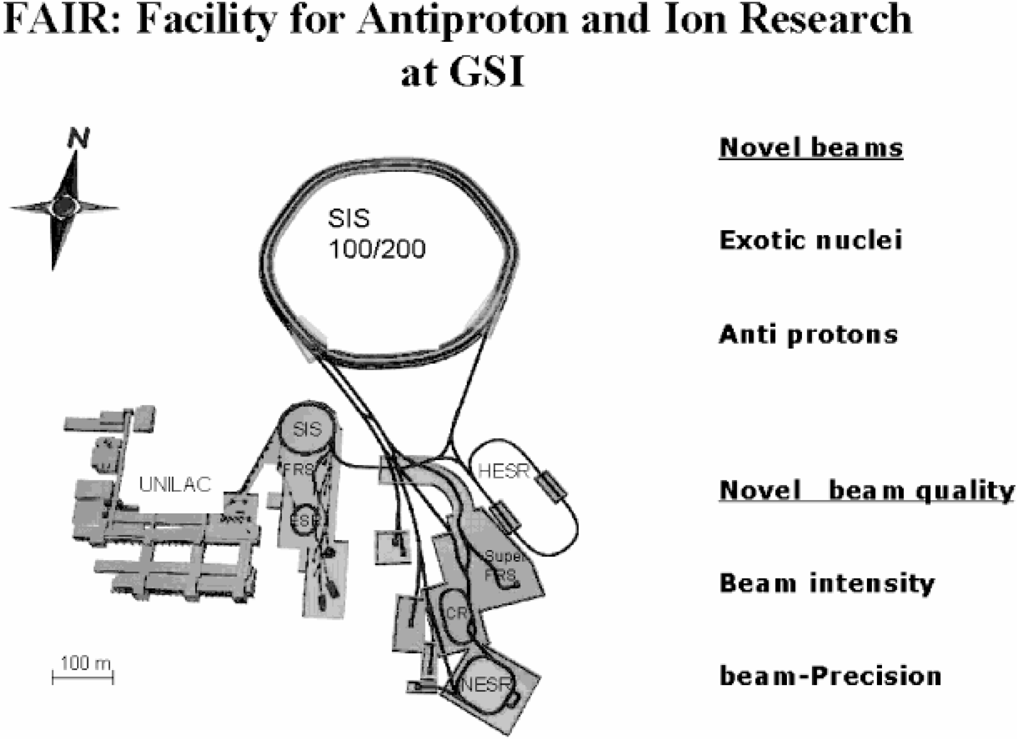
Layout of the new accelerator facility at GSI.
Laser drivers will play a unique role in the investigation of basic physics and technological issues associated with the process of inertial confinement. The repetition rate of laser shots will be compatible with the demands of such experiments, they will, however, be far from repetition rates of some Hz required by IFE production. Even though there are ideas to increase the repetition rate (Kong et al., 2005a, 2005b) and also the efficiency of laser systems to convert electrical energy into laser light, particle accelerators, heavy ion accelerators in particular are superior in this respect. However, the fast ignitor concept (Mulser & Bauer, 2004), offers excellent opportunities to combine heavy ion beams, light ion beams and powerful ultra-intense lasers to use the synergy of the respective beam properties for a driver concept (Roth et al., 2001). In fast ignition, a laser beam either penetrates directly into the pre-compressed target, through the process of hole boring (Mulser & Schneider, 2004), or the laser beam is first converted to an intense particle beam (Deutsch, 2004) which then is transported to the fuel for ignition. This scheme is still under development and needs a more detailed understanding of the interaction processes of ultra-intense laser fields with matter (Bauer, 2003). In basic physics research, high power lasers today are capable to produce conditions of astrophysical interest and some phenomena like jets (Schopper et al., 2003) can today be studied under laboratory conditions. Even low power-lasers can be used very efficiently to produce high current ion sources (Ogawa et al., 2003), however ultra intense laser fields are very successful to produce heavy ion beams with high brilliance (Roth et al., 2005). In order to address beam plasma interaction phenomena of lasers and ion beams, GSI operates two Nd:glass laser facilities. The NHELIX laser is capable to produce 150 J pulses with duration of 10 ns, and the newly built PHELIX laser will soon deliver 1 kJ in a long pulse version, and it is also designed to deliver a compressed beam (500 fs) with a total power of 1 petawatt. A first X-ray laser experiment was successful to achieve lasing of Ni-like zirconium at 22.02 nm (Neumayer, 2005). A schematic layout of the PHELIX laser system is shown in Fig. 2.
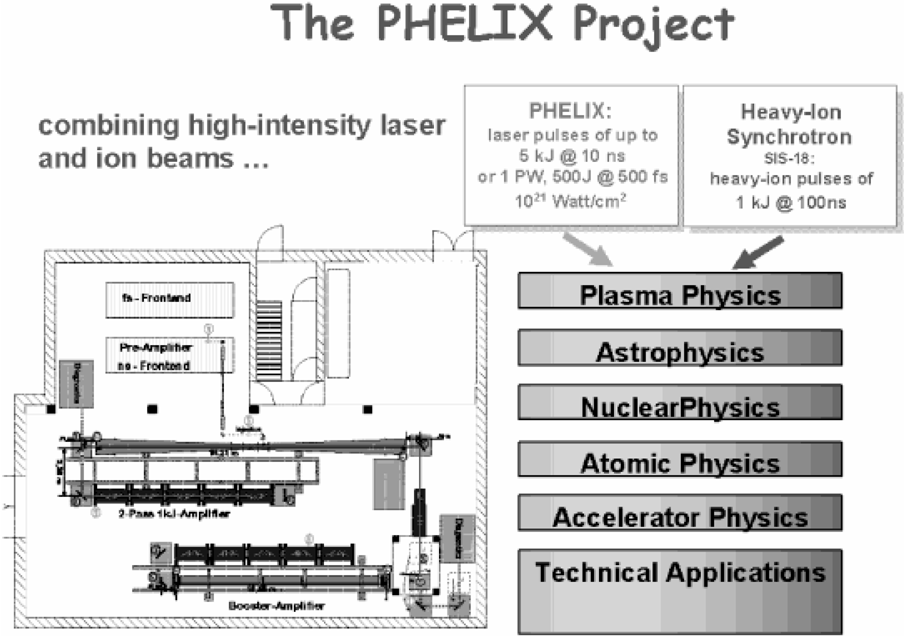
Schematic layout for the PHELIX laser system.
3. INTERACTION OF HEAVY IONS WITH SHOCKWAVE-DRIVEN NON-IDEAL PLASMAS
For non-ideal plasmas with Γ-parameters ≥ 1, theory predicts a deviation from the Z2 behavior for the energy loss of ions (Zwicknagel et al., 1999). However, experimental data to confirm this prediction does not currently exist. Experimentally, such plasmas can be generated from explosively compressed gases. In this case, a shockwave is generated from the detonation of 100 to 200g of a high explosive, which is launched into a gas filled glass cylinder. A planar shock wave then compresses the gas, turning it into dense low temperature plasma. In this experiment, the Γ-parameter could be varied between 0.5 and 1.5. This corresponds to Ar plasma with a density of 0.26 to 1.5 × 1020 cm−3, with a temperature of about 2 eV. The energy loss was measured with the energy loss method that was developed at GSI for beam plasma stopping power measurements (Weyrich et al., 1989). An enhanced energy loss as shown in Fig. 3 was measured for the compressed dense plasma phase when compared to the same line density of cold gas. However, the effect can also be produced by an enhancement of the ion charge state due to plasma effects. Therefore currently measurements are underway to investigate this effect with fully ionized carbon ions.
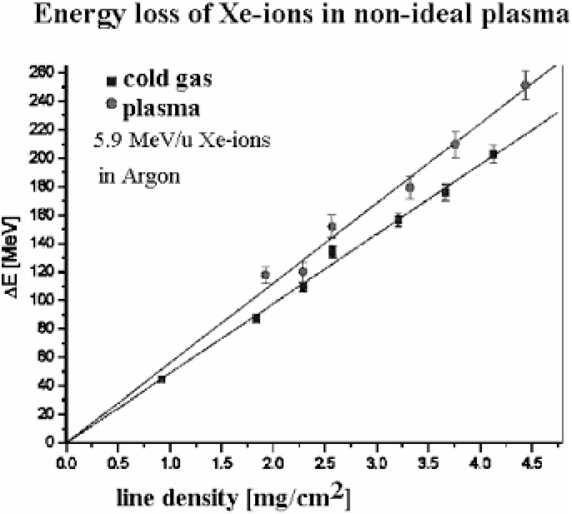
Energy loss of 5.9 MeV/u Xe-ions in Argon 4. High-Energy-Density studies using intense heavy ion beams.
Experiments using irradiation of rare gas crystals such as solid Ne and Xe by beams of heavy ions including U, Kr, and Ar have shown that a continuous reduction in the target density occurs due to hydrodynamic motion of the target material.
This in turn leads to a decrease in the energy loss of the projectile ions that causes an increase in the energy of the ions escaping the rear side of the target. Measurement of the energy loss dynamics (ELD) of the emerging beam therefore provides very valuable information about the material density. This is a unique feature of an intense heavy ion beam that the same beam which is used to create a sample of HED matter can also be used to diagnose the sample. First measurements of this kind have been reported by Varentsov et al. (2003).
In these experiments the duration of the beam was fairly long (few hundred ns to 1 μs). In the future GSI accelerator facilities, however, it is planned that the pulse length will be on the order of 50 to 100 ns. In such a case, the beam will only heat the target and no ions will be available to study the ELD.
To overcome this difficulty, it has been proposed (Hofmann et al., 2001) that one may allow generation of two beams, one high intensity, bunched beam that will heat the target and the other a low intensity un-bunched beam with a duration on the order of 1 μs that can be used for diagnostic purposes. Feasibility studies of such dual-beam schemes have been done for the upgraded SIS18 and the future SIS 100 at the FAIR facility, and detailed numerical simulations have also been carried out for interesting experiment designs (Tahir et al., 2002, 2003a).
In December 2003, high energy density experiments were carried out at the GSI using the most intense uranium beams generated so far. A beam intensity of 4 × 109 per bunch was achieved while the pulse length was compressed to a full width at half maximum (FWHM) of 125 ns. The particle energy was 350 MeV/u which corresponds to a total energy of 83.3 GeV and an elliptic beam spot was used. A thin (250 μm) foil of lead was vertically placed along the beam direction at the origin. The foil thickness was much smaller than the horizontal beam spot size, while the vertical beam extension was large. Such target geometry provides homogeneous volume heating of the sample and plane quasi-one-dimensional (1D) character of the hydrodynamic expansion of the heated matter. In order to limit the material expansion and to define the final volume, two sapphire plates were placed at appropriate distances on either side of the foil. In addition a tungsten diaphragm was installed in front of the foil to avoid undesirable heating of the regions close to the foil. The entire target assembly was placed inside a copper casing. In some experiments, the target was filled with helium gas. The radiation emitted by the target was recorded by a fast multi-channel optical pyrometer (displayed in Fig. 4) with time resolution which has been developed at the GSI in collaboration with IPCP Chernogolovka. This pyrometer analyzes the target radiation in the 500 to 1500 nm range. In these experiments, a maximum brightness temperature of 5000 K has been measured. Detailed numerical simulations have shown that a specific energy on the order of 1 kJ/g is deposited on the target by the beam. The analysis of the pyrometer data suggests a maximum temperature on the sample of 5000 K. In Fig. 5, the brightness temperature for three different wavelengths between 650 nm and 850 nm is plotted. When the beam intensity reaches its maximum, the temperature is just above 2500 K and continues to rise when the beam deposition process has already stopped. When hydrodynamic target expansion dominates a temperature decrease is observed. Later, when the target material hits the sapphire window, we observe sudden shock wave heating of a small amount of material. Detailed numerical simulations are currently performed to confirm the experimental observations.
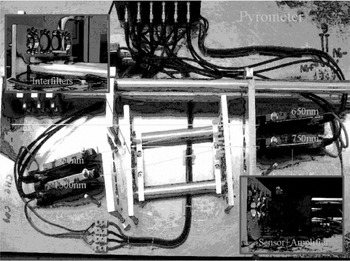
Fast radiation pyrometer with ns time resolution.
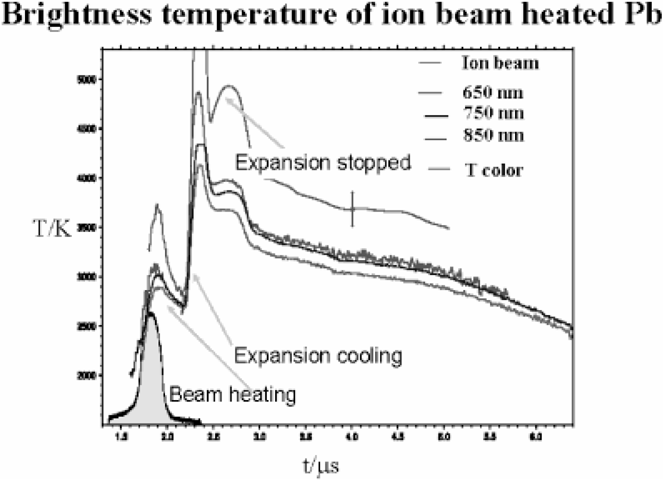
Typical pyrometer record. A lead target heated by a uranium ion beam. The curves represent (from bottom to top) the brightness temperature measured for 650 nm, 750 nm, and 850 nm as well as the total color temperature as a function of time.
Plane geometry is attractive because of its simplicity, but cylindrical geometry has its advantages too as it is the most natural geometry for an ion beam. It has been planned for the future that cylindrical targets will also be used in the heavy ion heating and expansion experiments (HIHEX). Uniformity of energy deposition in transverse direction can be achieved by assuming that the target radius is smaller than the beam radius, while if the target length is considered to be less than the ion range, the energy deposition along the cylinder length will be fairly uniform as well. Numerical simulations have shown (Tahir et al., 2003b) that using a uranium beam with an intensity of 1010 particles per bunch; one would be able to achieve super critical states for most of the metals including lead, gold, copper, and zinc. This beam intensity will be available in the near future at the SIS18 facility.
We chose lead for this experiment because it is one of the few metals, where the thermophysical properties are quite well known from shockwave experiments using high explosives. Therefore this material provides an ideal testing case for the new method to use intense heavy ion beams to generate high density states.
The beam intensities that will be available at the future FAIR facility will make it possible to study compression of matter using a hollow beam with an annular focal spot. Numerical simulations (Tahir et al., 2003) have shown that using such a beam configuration one can achieve a low entropy compression of a test material like hydrogen that is enclosed in a heavy metallic shell. In such experiments, one will be able to create physical conditions that exist in giant planets in our solar system and others. This class of experiments we call laboratory planetary sciences (LAPLAS). These experiments, we believe will also be very useful to study the problem of hydrogen metallization. While for compression experiments to achieve metallization of hydrogen, an annular beam focus is necessary (Neuner et al., 2000; Piriz et al., 2003; Temporal et al., 2003), the previously described HIHEX method just requires a smooth intensity profile of gaussian shape or eventually a flat top.
References
REFERENCES

Layout of the new accelerator facility at GSI.

Schematic layout for the PHELIX laser system.

Energy loss of 5.9 MeV/u Xe-ions in Argon 4. High-Energy-Density studies using intense heavy ion beams.

Fast radiation pyrometer with ns time resolution.

Typical pyrometer record. A lead target heated by a uranium ion beam. The curves represent (from bottom to top) the brightness temperature measured for 650 nm, 750 nm, and 850 nm as well as the total color temperature as a function of time.
- 175
- Cited by


